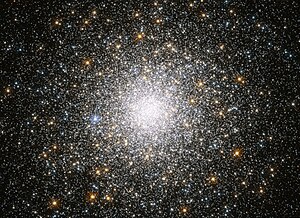| Messier 75 | |
|---|---|
 | |
| Observation data (J2000 epoch) | |
| Class | I[1] |
| Constellation | Sagittarius |
| Right ascension | 20h 06m 04.85s[2] |
| Declination | −21° 55′ 17.85″[2] |
| Distance | 68 kly (20.9 kpc)[3] |
| Apparent magnitude (V) | 8.5[4] |
| Apparent dimensions (V) | 6.8′ |
| Physical characteristics | |
| Absolute magnitude | −8.57[2] |
| Radius | 67 ly[5] |
| Tidal radius | 5.7′[3] |
| Metallicity | = −1.29[6] dex |
| Other designations | GCl 116, M75, NGC 6864[7] |
Messier 75 or M75, also known as NGC 6864, is a giant globular cluster of stars in the southern constellation Sagittarius.[a] It was discovered by Pierre Méchain in 1780 and included in Charles Messier's catalog of comet-like objects that same year.[8]
M75 is about 67,500[3] light years away from Earth and is 14,700[6] light years away from, and on the opposite side of, the Galactic Center.[9] Its apparent size on the sky translates to a true radius of 67 light years.[5] M75 is classified as class I, meaning it is one of the more densely concentrated globular clusters known. It shows a slow rotation around an axis that is inclined along a position angle of −15°±30°.[3] The absolute magnitude of M75 is about −8.5, equating to 180,000 times more luminous than the Sun (L☉).[8]
The cluster has a half-light radius of 9.1 ly (2.80 pc)[6] with a core radius of about 1.6 ly (0.5 pc) and appears not to have undergone core collapse yet. The mass density at the core is 7.9×104 M☉·pc−3.[b][2] There are 38 RR Lyrae variable stars and the cluster appears to be Oosterhoff-intermediate in terms of metallicity.[9] 62 candidate blue stragglers have been identified in the cluster field, with 60% being in the core region.[2]
Messier 75 is part of the Gaia Sausage, the hypothesized remains of a dwarf galaxy that merged with the Milky Way.[10] It is a halo object with an orbital period of 0.4 billion years to travel around the galaxy on a very pronounced ellipse, specifically eccentricity of 0.87. The apocenter (maximal distance from Earth) is about 57,000 ly (17,500 pc).[3]
- ^ Cite error: The named reference
hcob849_11was invoked but never defined (see the help page). - ^ a b c d e Cite error: The named reference
Ramos2012was invoked but never defined (see the help page). - ^ a b c d e Cite error: The named reference
Koch2018was invoked but never defined (see the help page). - ^ "Messier 75". SEDS Messier Catalog. Retrieved 30 April 2022.
- ^ a b From trigonometry: radius = distance × sin( diameter_angle / 2 ) = 67 ly.
- ^ a b c Cite error: The named reference
Bergh2012was invoked but never defined (see the help page). - ^ Cite error: The named reference
simbadwas invoked but never defined (see the help page). - ^ a b Cite error: The named reference
Frommert2007was invoked but never defined (see the help page). - ^ a b Cite error: The named reference
Corwin2003was invoked but never defined (see the help page). - ^ Cite error: The named reference
Myeong2018was invoked but never defined (see the help page).
Cite error: There are <ref group=lower-alpha> tags or {{efn}} templates on this page, but the references will not show without a {{reflist|group=lower-alpha}} template or {{notelist}} template (see the help page).
![{\displaystyle {\begin{smallmatrix}\left[{\ce {Fe}}/{\ce {H}}\right]\end{smallmatrix}}}](https://wikimedia.org/api/rest_v1/media/math/render/svg/4c0821bd80891e071c08e7c7ee8e022baedf522c)